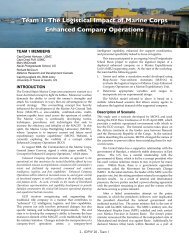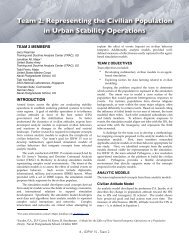pdf file - SEED Center for Data Farming - Naval Postgraduate School
pdf file - SEED Center for Data Farming - Naval Postgraduate School
pdf file - SEED Center for Data Farming - Naval Postgraduate School
Create successful ePaper yourself
Turn your PDF publications into a flip-book with our unique Google optimized e-Paper software.
that is suited <strong>for</strong> data farming, execution of large numbers of<br />
repetitions of parametric runs to identify behaviors overlaid<br />
on a dynamic landscape). A concept sketch and screenshot of<br />
the base case scenario implemented in Pythagoras are shown<br />
in Figures 2 and 3, respectively.<br />
Figure 3. Agent-based Approach in Pythagoras.<br />
Design of Experiments<br />
The design of experiment (DOE) methodology will help<br />
us to gain insights on sensor system behavior and its<br />
interaction with key factors. Our goal is to gain such insights<br />
from factors that influence the disruption of tunnel<br />
construction and use. We will use Pythagoras, developed by<br />
Northrop Grumman, to represent tunnel detection and<br />
interdiction assets along a cross-border region of interest.<br />
During model development, we created notional factors<br />
(Table 1) that define both the characteristics and per<strong>for</strong>mance<br />
capabilities of the CBP sensor management system and the<br />
tunneling activities that it was designed to defeat.<br />
Our scenario consists of a region along the United States/<br />
Mexico border with representative road and building<br />
infrastructure as previously depicted in Figures 2 and 3. We<br />
will develop agents to represent the CBP system of systems<br />
(SoS) and threat as represented in Figure 1. Agents will<br />
include team members, vehicles, and ground sensors that<br />
encompass the SME/HQ Fusion <strong>Center</strong>, Site Investigation,<br />
Interdiction, Special Operations, Exploration, and<br />
Remediation teams, and associated sensor networks. The<br />
threat agents will consist of tunneling construction entities<br />
(digging and conveyance).<br />
Our specific design will capture the factors relevant to the<br />
CBP SoS. Such factors include the type and number of sensors<br />
employed, sensor per<strong>for</strong>mance, configuration and field<br />
emplacement characteristics, the number and behavior of<br />
members in the CBP teams, as well as the characteristics of<br />
tunneling entities.<br />
We anticipate that numerous factors consisting of<br />
multiple levels will be required to model the scenario.<br />
Employing a full factorial experiment with the 23 factors<br />
Table 1. Notional Factors Representing the CBP Sensor<br />
Management System and Tunneling Activities.<br />
presented in Table 1, each set at two levels (low & high),<br />
would result in 323 design points. A pairwise projection <strong>for</strong><br />
the first four factors of such a design is displayed in Figure 4.<br />
Fortunately, there are more efficient alternatives to using a full<br />
factorial design.<br />
Figure 4. Scatterplot Matrix of a Factorial Design <strong>for</strong> Four Factors.<br />
48 - IDFW 20 - Team 13




